|
Young Investigator Awards
|
0036.
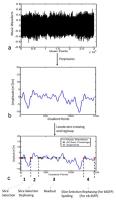 |
Music-Based Magnetic Resonance Fingerprinting to Improve Patient
Comfort During MRI Examinations
Dan Ma1, Eric Y. Pierre2, Yun Jiang 2,
Mark D. Schluchter3, Kawin Setsompop4,
Vikas Gulani1, and Mark Griswold1
1Radiology, Case Western Reserve University,
Cleveland, OH, United States, 2Biomedical
Engineering, Case Western Reserve University, Cleveland, OH,
United States, 3Epidemiology
& Biostatistics, Case Western Reserve University, Cleveland,
OH, United States, 4A.A
Martinos Center for Biomedical Imaging, Massachusetts
General Hospital, Boston, MA, United States
An acquisition method named MRF-Music is proposed to
mitigate the acoustic noise during MRI scans by producing
musical sounds directly from the switching magnetic fields
while simultaneously quantifying multiple important tissue
properties. MP3 music files were converted to arbitrary
encoding gradients, which were then used with varying flip
angles and TRs in both 2D and 3D MRF exam to generate T1, T2
and proton density maps. The MRF-Music scans were shown to
significantly improve patients’ comfort. T1 and T2 measured
from phantom and in vivo scans were also in good agreement
with those from the standard measurements and reported
values.
|
|
0037.
 |
Simultaneous assessment of cardiac metabolism and perfusion
using co-polarized [1-13C]pyruvate and 13C-urea
Angus Zoen Lau1,2, Jack Miller2,3,
Matthew D Robson1, and Damian J Tyler1,2
1Cardiovascular Medicine, University of Oxford,
Oxford, United Kingdom, 2Department
of Physiology, Anatomy, and Genetics, University of Oxford,
Oxford, United Kingdom, 3Department
of Physics, Clarendon Laboratory, Oxford, United Kingdom
Assessment of cardiac metabolism and perfusion using
hyperpolarized 13C
substrates enables discrimination between viable,
hibernating, and non-viable tissue, but current methods
require two separate injections of pre-polarized [1-13C]pyruvate
and 13C-urea,
respectively. We propose to use an infusion of co-polarized
[1-13C]pyruvate/13C-urea combined with
a flow-sensitized pulse sequence to simultaneously assess
both of these parameters in a single injection. Perfusion
and metabolic state are modulated using specific
interventions, and subsequently detected using the new scan.
This probe of both myocardial perfusion and metabolism is
anticipated to enable metabolic study of the heart in acute
scenarios.
|
|
0038.
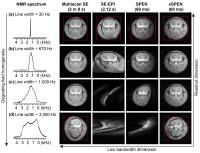 |
xSPEN: Single-shot magnetic resonance imaging with exceptional
resilience to field heterogeneities
Zhiyong Zhang1, Amir Seginer1, and
Lucio Frydman1
1Chemical Physics, Weizmann Institute of Science,
Rehovot, Israel
Single-shot MRI has been constrained to acquisitions in
quality magnets and homogeneous tissues. The present study
introduces a methodology that can deliver such images with
good SNR, under much poorer field and/or multiple shift
conditions. These capabilities are achieved based on new
principles whereby images are read using field gradients
that are not applied along the direction being encoded. This
enables one to accommodate shifts/inhomogeneities into the
single-scan image generation protocol, without suffering
from miss-registrations, without requiring a priori
information for post-acquisition corrections, and without
demanding specialized instrumentation. This enables new
single-shot investigations that have hitherto escaped from
MRI’s scope.
|
|
0039.
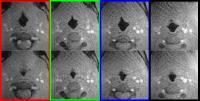 |
Evaluation of Upper Airway Collapsibility Using Simultaneous
Multi-Slice Real-Time MRI
Ziyue Wu1,2, Weiyi Chen1, Michael C.K.
Khoo1, Sally L. Davidson Ward3, and
Krishna S. Nayak1
1University of Southern California, Los Angeles,
CA, United States, 2Alltech
Medical Systems, Solon, OH, United States, 3Children's
Hospital Los Angeles, Los Angels, CA, United States
We present a method for simultaneous multi-slice airway
collapsibility measurement based on sparse golden-angle
radial CAIPIRINHA, with acceleration factor up to 33.3. We
present data from patients with obstructive sleep apnea and
normal controls. One interesting finding is that a narrower
airway site does not always correspond to higher
collapsibility. This finding may be of interest to sleep
surgeons. Our results also suggest that both compliance and
Pclose were
significantly different between healthy controls and OSA
patients (P<0.001), and both measures can potentially serve
as biomarkers.
|
|
0040.
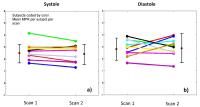 |
Interstudy repeatability of self-gated quantitative myocardial
perfusion MRI
Devavrat Likhite1, Promporn Suksaranjit2,
Ganesh Adluru1, Nan Hu3, Cindy Weng3,
Eugene Kholmovski1, Chris McGann2,
Brent Wilson2, and Edward DiBella1
1Utah Center for Advanced Imaging Research,
Department of Radiology, University of Utah, Salt Lake City,
UT, United States, 2Division
of Cardiovascular Medicine, University of Utah, Salt Lake
City, UT, United States,3Department of Internal
Medicine, University of Utah, Salt Lake City, UT, United
States
Dynamic contrast enhanced MRI is maturing as a tool in
contemporary cardiovascular medicine. A self-gated method
that avoids the use of ECG-gating signal has been validated
by us for quantitative myocardial perfusion. Our most recent
study looks at the inter-study repeatability of this
quantitative self-gated method. Our findings show that the
multi-slice self-gated (near-systole) approach has a
comparable or better repeatability than published ECG-gated
single slice studies. The purpose of this abstract is to
summarize these findings from our recent work, highlighting
the simplicity, ease of use and reliability of the
self-gated method for quantitative myocardial perfusion.
|
|
0041.
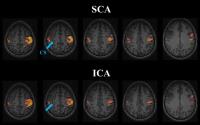 |
Neurovascular uncoupling in resting state fMRI demonstrated in
patients with primary brain gliomas
Shruti Agarwal1, Haris I. Sair1,
Noushin Yahyavi-Firouz-Abadi1, Raag Airan1,
and Jay J. Pillai1
1Division of Neuroradiology, Russell H. Morgan
Department of Radiology and Radiological Science, Johns
Hopkins University School of Medicine, Baltimore, MD, United
States
One of the most important potential limitations of
presurgical mapping using blood oxygen level dependent
functional magnetic resonance imaging (BOLD fMRI) is the
phenomenon of neurovascular uncoupling (NVU). NVU can lead
to erroneous interpretation of clinical fMRI examinations.
The effects of brain tumor-related NVU on task-based BOLD
fMRI have been previously published. The purpose of this
study is to demonstrate that the problem of brain
tumor-related NVU is a significant issue with respect to
resting state BOLD fMRI similar to task-based BOLD fMRI, in
which signal detectability can be compromised by breakdown
of normal neurovascular coupling.
|
|





